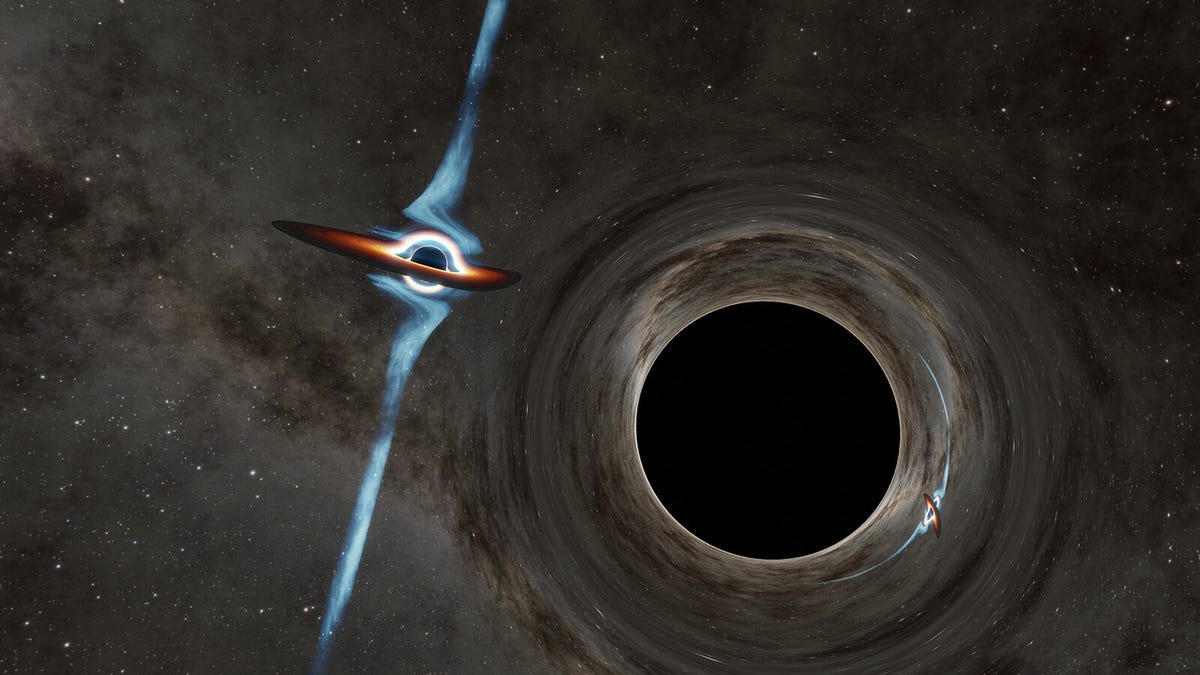Two Supermassive Black Holes on Track to Collide Will Warp Space and Time
One researcher relates the epic discovery of these supermassive voids to "a good detective novel." In about 10,000 years, they'll merge and send ripples across the universe.

Two colossal black holes will collide in approximately 10,000 years, rippling across the universe.
Some 9 billion light-years away, two gargantuan black holes are revolving around one another -- and rather ominously. This dance won't last forever. Around 10,000 years from now, the pair will collide. They'll merge into a single deafening abyss with a force immense enough to warp the fabric of space and time with an eruption of ripples.
Each supermassive void is so unfathomably huge, our minds can barely comprehend their heft and reach. They're hundreds of millions of times the mass of our sun, yet quite close together on a relative cosmic scale -- separated by about 50 times the distance between Earth and Pluto. For context, a black hole merely half the size of a golf ball would have a mass equivalent to our entire planet.
On Wednesday, in The Astrophysical Journal Letters, researchers published a study on the waltzing chasms, calling this system the second known candidate of impending supermassive black hole mergers ever found. And as it appears, the black holes' spectacle is paralleled by an equally dramatic chronicle of discovery.
An artist's conception of the binary black hole system revolving around one another. The more massive black hole is shooting out a jet that changes in its apparent brightness as the duo circles each other.
In 2008, study co-author Tony Readhead, an astronomer from the California Institute of Technology, and colleagues began watching the sky for galaxies with cores holding active black holes. More specifically, they searched for voids with central jets that spew streams of matter at incredible velocities nearing the speed of light, which thereby flood the universe with luminescence.
Typically, such energetic galactic centers are called quasars, but Readhead's goal was to find a subclass of quasar called a blazar. In short, blazars' jets are pointed directly at Earth. For years, Readhead successfully monitored about 1,000 of these enormous beams. Then in 2020, something strange revealed itself. A black hole jet dubbed PKS 2131-021 stood out because it exhibited a particular repetition of light variation Readhead calls a sinusoidal pattern. Sinusoidal patterns essentially look like waves on a diagram going up and down. You can think of them as having hills and valleys.
Zeroing in on this blip, Readhead checked out how far back the shape goes. After analyzing radio telescope data from powerful machines such as the National Radio Astronomy's Very Long Baseline Array, the team found the pattern traced back to 1981.
But due to a ton of gaps in the sine wave's consistency, "the story would have stopped there, as we didn't realize there were data on this object before 1980," Readhead said in a statement. "But then Sandra picked up this project in June of 2021," referring to lead author of the new study, Sandra O'Neill, an undergraduate student at Caltech. "If it weren't for her, this beautiful finding would be sitting on the shelf."
O'Neill found the pattern stretched all the way to the '70s, and maintained a much stronger consistency back then. In a statement, O'Neill said, "when we realized that the peaks and troughs of the light curve detected from recent times matched the peaks and troughs observed between 1975 and 1983, we knew something very special was going on."
That's when co-author Roger Blandford, an astrophysicist at Caltech, stepped in. Per Readhead, Blandford drew up a model of the sine wave, and found the pattern was due to the motion of not one but two black holes, though only one emanates the jet with a fluctuating sinusoidal light pattern. Blandford also helped realize the supermassive voids finish an orbit around one another once every two years, or five years after taking into account the universe's expansion rate. "Before Roger worked it out," Readhead said, "nobody had figured out that a binary with a relativistic jet would have a light curve that looked like this."
Artist's animation of a supermassive black hole circled by a spinning disk of gas and dust. The black hole is shooting out a relativistic jet -- one that travels at nearly the speed of light.
Perhaps most strikingly, the finding of PKS 2131-021's binary black hole system could aid in studies of gravitational waves, or ripples in the universe formed by super strong gravitational forces. First discussed by Albert Einstein a century ago, the existence of gravitational waves was long considered unprovable as the ripples are a consequence of general relativity, which mind-bendingly coins space-time as a sort of tangible, wave-able fabric.
But such skepticism dissolved in 2016. Scientists from the Laser Interferometer Gravitational Wave Observatory, aka LIGO, shocked the world when they announced the detection of such waves for the first time as the result of two black holes colliding, which, as you can imagine, generated a mighty gravitational force. Essentially, LIGO proved Einstein's fascinating conjecture at last: Space-time is a fabric that can be rippled by gravity the way dropping a coin in a lake would send ripples across the water.
But while LIGO continues to trail-blaze in studying the warping of space-time, the study authors emphasize its detector can't catch ripples caused by supermassive black holes like the two found in PKS 2131-021. LIGO, they say, tops out at finding waves produced by voids only about dozens of times the mass of our sun.
Thus, scientists need to detect sinusoidal light wave patterns created by black hole jets for abysses any bigger. "This work shows the value of doing accurate monitoring of these sources over many years for performing discovery science," Blandford said in a statement.
And rather aptly, Readhead compares the saga of these enormous black holes to a "good detective novel."

